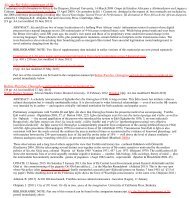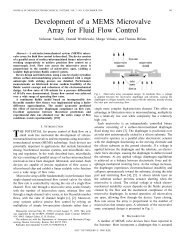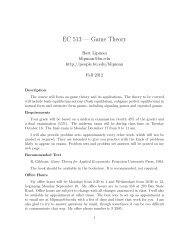CUP2 binds in a bipartite manner to upstream activation sequence c ...
CUP2 binds in a bipartite manner to upstream activation sequence c ...
CUP2 binds in a bipartite manner to upstream activation sequence c ...
You also want an ePaper? Increase the reach of your titles
YUMPU automatically turns print PDFs into web optimized ePapers that Google loves.
456<br />
<strong>in</strong>g nucleoside results were observed with the <strong>CUP2</strong>TR<br />
prote<strong>in</strong> (data not shown).<br />
Miss<strong>in</strong>g nucleoside analysis of ace1<br />
The miss<strong>in</strong>g nucleoside pattern we f<strong>in</strong>d for the ace1<br />
complex II fraction reveals that ace1 makes important<br />
<strong>in</strong>teractions with a stretch of n<strong>in</strong>e base pairs with<strong>in</strong><br />
each half-site of UASc, with both nucleosides of each<br />
base pair contribut<strong>in</strong>g <strong>to</strong> b<strong>in</strong>d<strong>in</strong>g (Fig. 4). These two regions,<br />
nucleotides –120 <strong>to</strong> –112 <strong>in</strong> the downstream halfsite<br />
and –136 <strong>to</strong> –127 <strong>in</strong> the <strong>upstream</strong> half-site, are symmetrical<br />
about the pseudodyad at base pair –124.<br />
The cleavage pattern of DNA isolated from complex<br />
I <strong>in</strong>dicates that only nucleosides –120 <strong>to</strong> –112 <strong>in</strong> the<br />
downstream half-site of UASc are essential for b<strong>in</strong>d<strong>in</strong>g<br />
of ace1. In the unbound fraction a complementary enhancement<br />
of band <strong>in</strong>tensities is observed. Our results<br />
for the unbound fraction and for complex I, along with<br />
previously reported methylation <strong>in</strong>terference data [14],<br />
<strong>in</strong>dicate that ace1 has a strong preference for b<strong>in</strong>d<strong>in</strong>g <strong>to</strong><br />
the downstream half-site. Thus, under the conditions of<br />
our experiment, the aff<strong>in</strong>ity of ace1 for the <strong>upstream</strong><br />
half-site is so low relative <strong>to</strong> its aff<strong>in</strong>ity for the downstream<br />
site that there is little b<strong>in</strong>d<strong>in</strong>g of ace1 <strong>to</strong> the <strong>upstream</strong><br />
site even when the downstream site has suffered<br />
the loss of a critical nucleoside.<br />
Discussion<br />
<strong>CUP2</strong> b<strong>in</strong>d<strong>in</strong>g <strong>to</strong> UASc<br />
The results of hydroxyl radical footpr<strong>in</strong>t<strong>in</strong>g and miss<strong>in</strong>g<br />
nucleoside experiments <strong>in</strong>dicate that <strong>CUP2</strong> <strong>in</strong>teracts<br />
with both half-sites of UASc, spann<strong>in</strong>g <strong>sequence</strong> positions<br />
–142 <strong>to</strong> –109 (Fig. 5). In each half-site, these <strong>in</strong>teractions<br />
extend one and one half turns from the dyad<br />
center. With<strong>in</strong> each half-site there is one strong hydroxyl<br />
radical footpr<strong>in</strong>t which is offset <strong>in</strong> the 3b direction<br />
from one strand <strong>to</strong> the other, <strong>in</strong>dicative of protection<br />
across the m<strong>in</strong>or groove [15]. Previous methylation <strong>in</strong>terference<br />
studies <strong>in</strong>dicated that <strong>CUP2</strong> <strong>in</strong>teracts with<br />
the major groove of the DNA directly flank<strong>in</strong>g the regions<br />
protected from hydroxyl radical cleavage [14].<br />
We observe miss<strong>in</strong>g nucleoside signals throughout the<br />
regions where methylation <strong>in</strong>terference signals occur<br />
and where hydroxyl radical footpr<strong>in</strong>ts are seen.<br />
Collectively, these data lead <strong>to</strong> a model for the complex<br />
<strong>in</strong> which <strong>CUP2</strong> makes contacts <strong>in</strong> the major<br />
groove one half turn and one and one half turns <strong>to</strong><br />
either side of the center of UASc, with the prote<strong>in</strong><br />
cross<strong>in</strong>g over the m<strong>in</strong>or groove between these major<br />
groove <strong>in</strong>teractions (Fig. 5). Although UASc can be<br />
considered <strong>to</strong> be an <strong>in</strong>verted repeat around a dyad axis<br />
of symmetry centered at position –124, if the G7C base<br />
pair at position –120 is elim<strong>in</strong>ated [14], the <strong>in</strong>teractions<br />
of <strong>CUP2</strong> with the two half-sites are not completely<br />
Fig. 5 Compilation of DNA b<strong>in</strong>d<strong>in</strong>g data for <strong>CUP2</strong> mapped on a<br />
10.5 bp per turn double helical representation of UASc. The <strong>sequence</strong><br />
of UASc is shown below the DNA helix. Dots are placed<br />
every 10 bp, from position –140 at the left <strong>to</strong> –110 at the right.<br />
Horizontal arrows demarcate the region of almost perfect dyad<br />
symmetry. The ellipse <strong>in</strong> the center of the DNA helix is placed at<br />
position –124, the site of the pseudodyad. A rectangle encloses the<br />
extra G7C base pair at position –120 that <strong>in</strong>terrupts dyad symmetry.<br />
The results of several k<strong>in</strong>ds of experiment are mapped on the<br />
DNA helix. Bases at which miss<strong>in</strong>g nucleoside signals are observed<br />
are marked by filled squares. Nucleotides protected from<br />
cleavage by the hydroxyl radical are <strong>in</strong>dicated by circles on the<br />
sugar-phosphate backbone. Bases at which methylation <strong>in</strong>terference<br />
was observed [14] are marked by a carat near the DNA helix.<br />
The results of analysis of po<strong>in</strong>t mutations [5] are <strong>in</strong>dicated by<br />
rectangles below the DNA <strong>sequence</strong>: solid non<strong>in</strong>ducible, moderately<br />
shaded ~25% <strong>in</strong>ducible, lightly shaded ~75% <strong>in</strong>ducible.<br />
The bracket above the DNA helix spann<strong>in</strong>g positions –142 <strong>to</strong><br />
–139 highlights the additional asymmetric contacts made by<br />
<strong>CUP2</strong> <strong>in</strong> the <strong>upstream</strong> half-site of UASc (see text for discussion).<br />
No correspond<strong>in</strong>g contacts symmetrically disposed across the<br />
dyad at <strong>sequence</strong> positions –108 <strong>to</strong> –105 are observed<br />
symmetrical. <strong>CUP2</strong> makes energetically important contacts<br />
with an additional 4 base pairs <strong>in</strong> the <strong>upstream</strong><br />
half-site. The location of these additional contacts is <strong>in</strong>dicated<br />
by the bracket above nucleotides –142 <strong>to</strong> –139<br />
<strong>in</strong> Fig. 5, outside the UASc <strong>in</strong>verted repeat.<br />
In general these results agree with previous DNase I<br />
footpr<strong>in</strong>t<strong>in</strong>g and methylation <strong>in</strong>terference experiments<br />
[14]. In addition, the nucleotide contacts we observe <strong>in</strong><br />
the <strong>upstream</strong> half of UASc are nearly identical <strong>to</strong> those<br />
recently found by the related miss<strong>in</strong>g contact technique<br />
for wild-type <strong>CUP2</strong> bound <strong>to</strong> a DNA construct conta<strong>in</strong><strong>in</strong>g<br />
only the <strong>upstream</strong> half-site [17].<br />
Comparison with po<strong>in</strong>t mutation analysis<br />
The miss<strong>in</strong>g nucleoside experiment reveals the nucleosides<br />
that make energetically important contributions<br />
<strong>to</strong> the formation of a prote<strong>in</strong>-DNA complex. It might<br />
be expected that the essential base pairs revealed by<br />
po<strong>in</strong>t mutation studies would be a subset of the contacts<br />
found <strong>in</strong> miss<strong>in</strong>g nucleoside experiments.<br />
Hamer and coworkers [5] found 21 transition mutations<br />
<strong>in</strong> UASc that decrease the level of copper-<strong>in</strong>duced<br />
transcription. Their results are summarized <strong>in</strong><br />
Fig. 5. Twelve of these mutants occur <strong>in</strong> the <strong>upstream</strong><br />
half of UASc, 11 of which are completely non<strong>in</strong>ducible.<br />
These results led these workers <strong>to</strong> propose as the <strong>CUP2</strong><br />
b<strong>in</strong>d<strong>in</strong>g site a 16-bp region <strong>in</strong> the <strong>upstream</strong> half-site of<br />
UASc [5]. From the results presented here, and from







